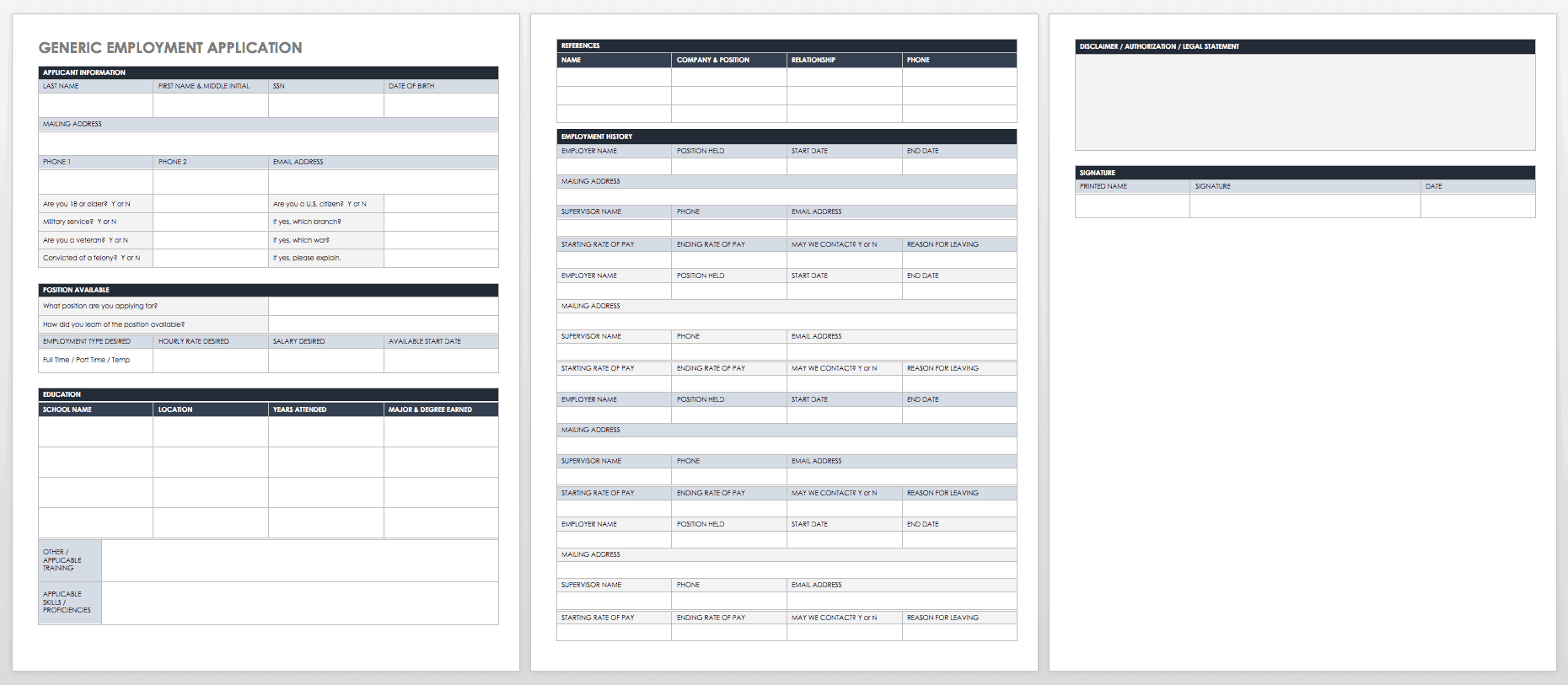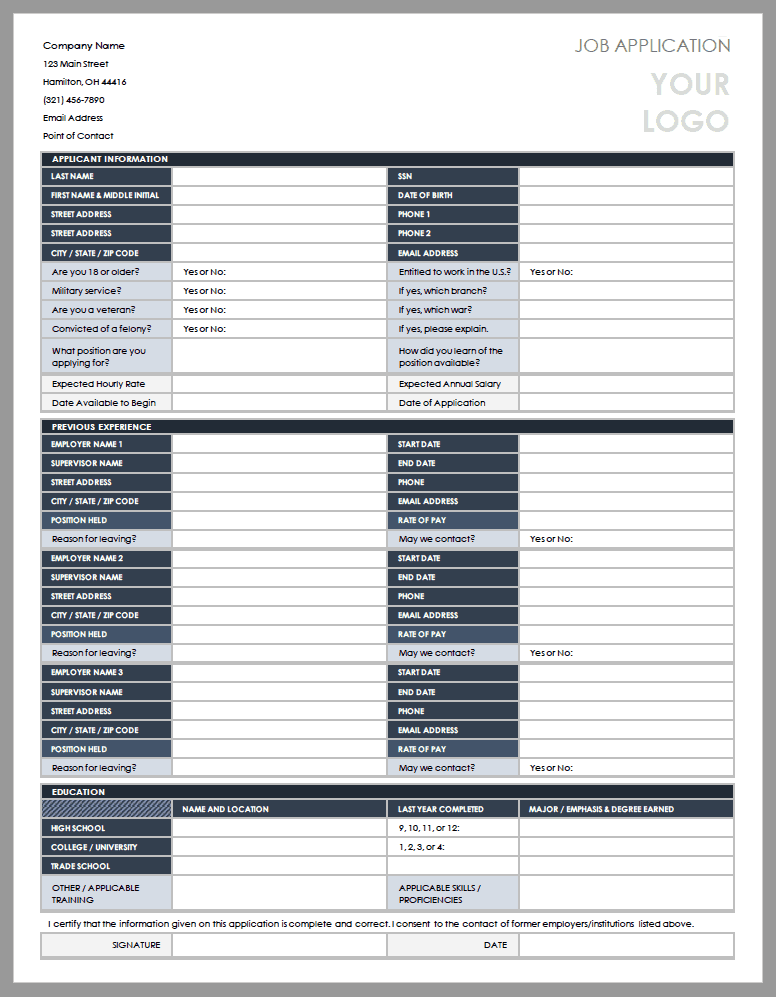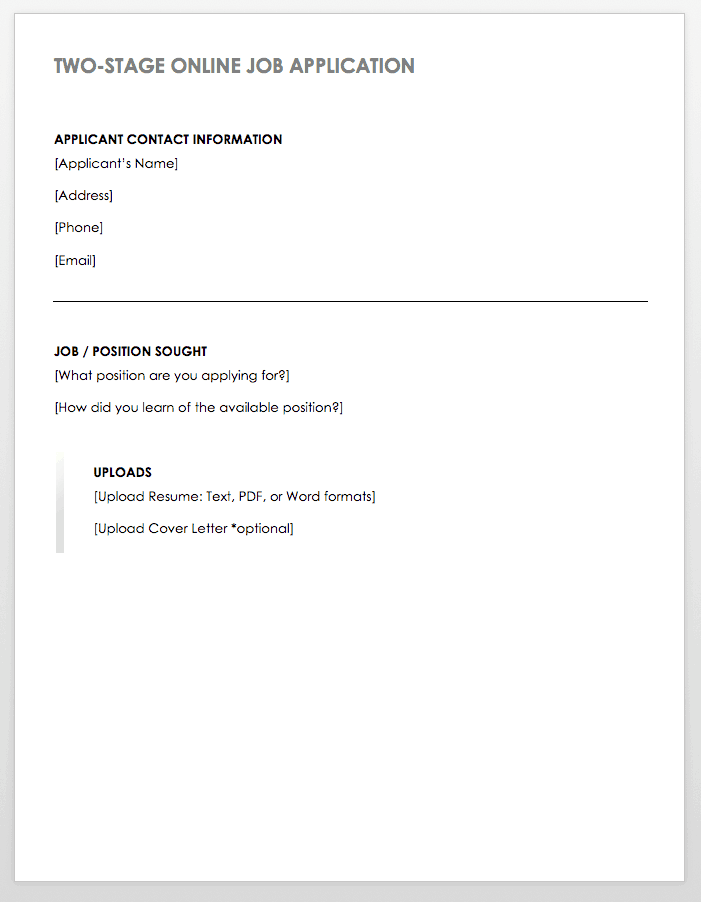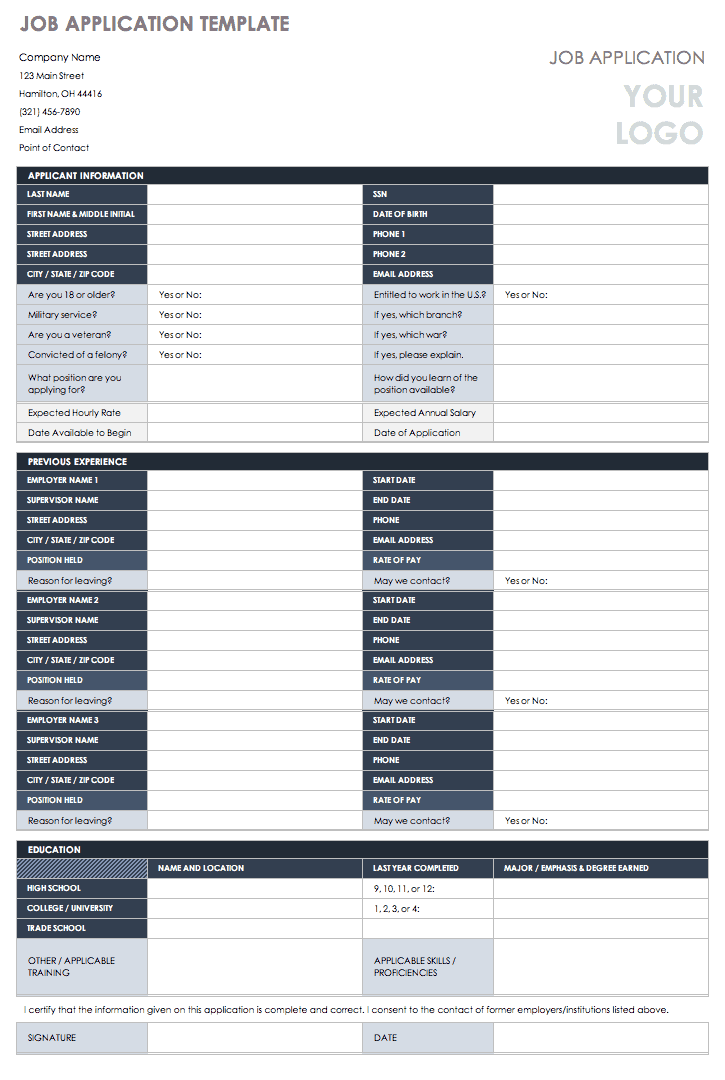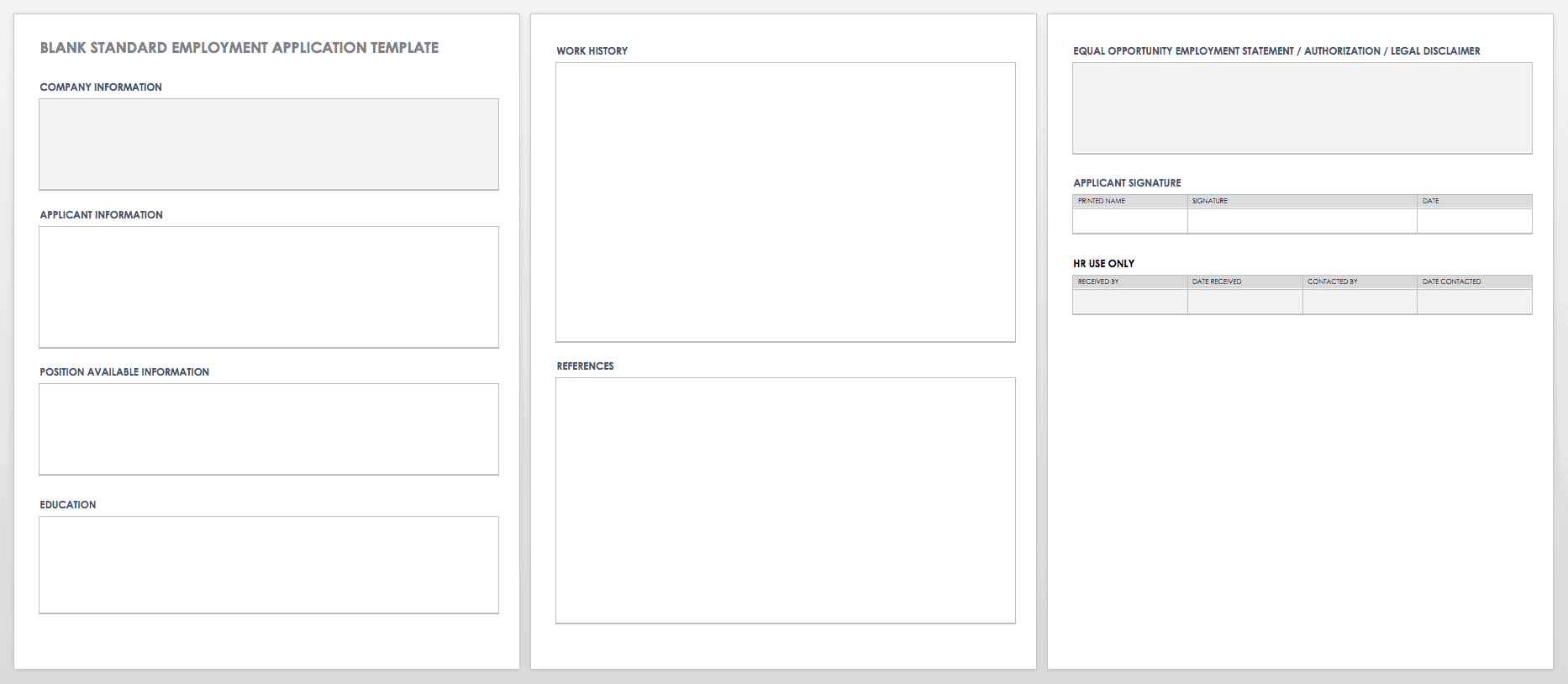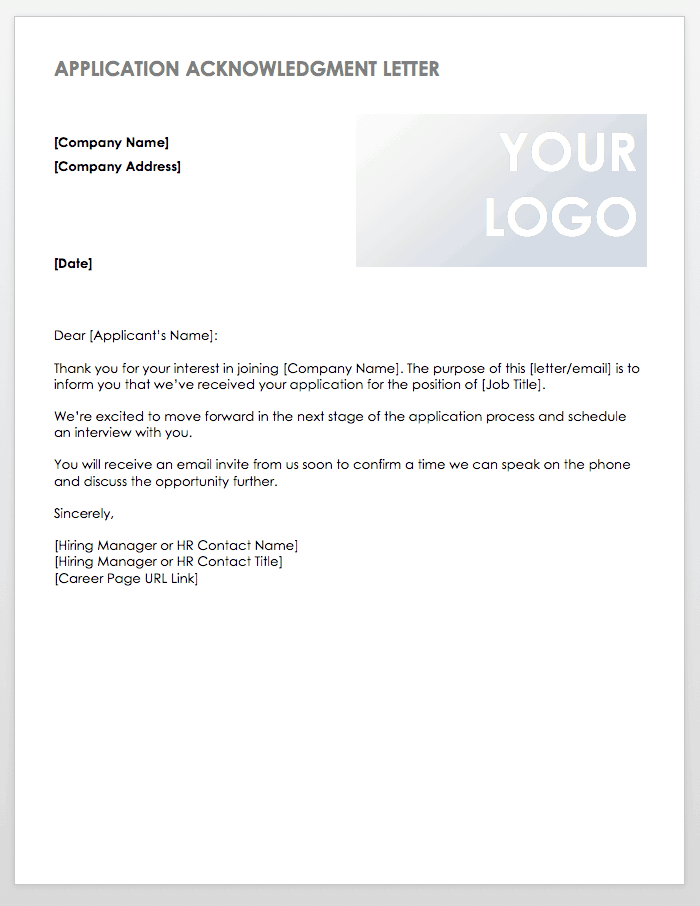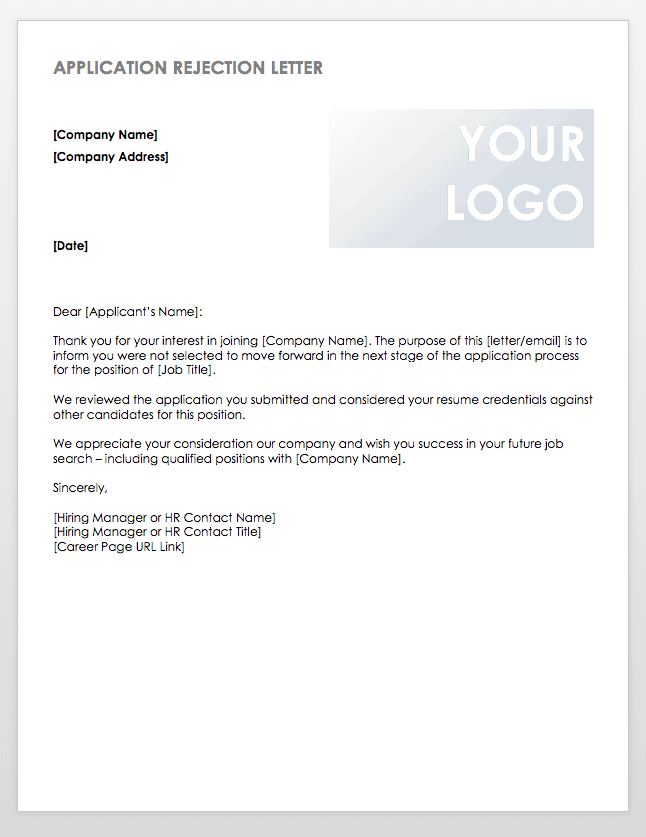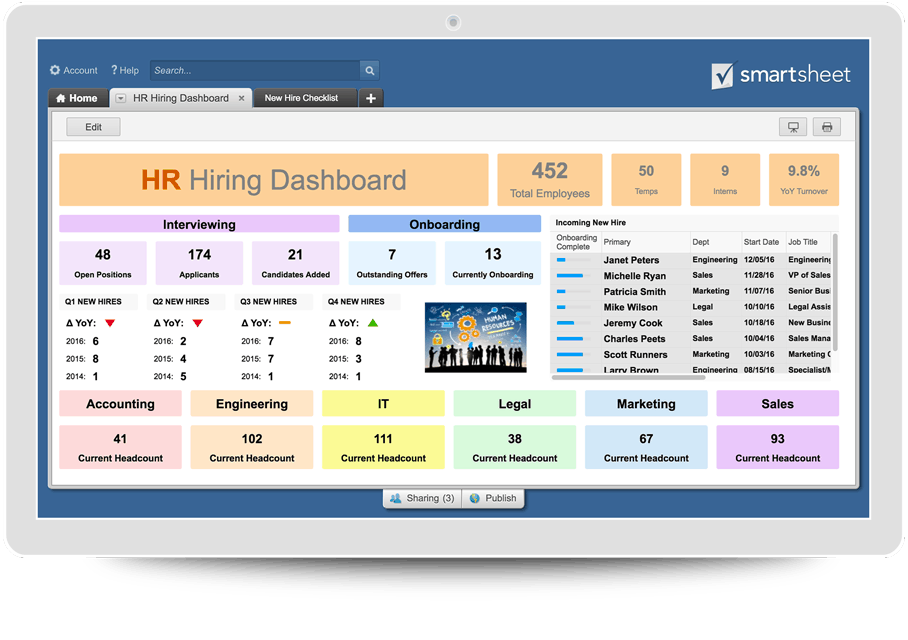Generic Employment Application Template
This template is a generic employment application PDF form designed with the standard sections to collect applicant data. There are no sections for an applicant signature or legal disclaimers and voluntary statements.
Download Generic Employment Application Template
Excel | Word | PDF | Smartsheet
Printable Job Application Template
If you’re looking for a simplified, ready-to-use job application, use this printable PDF application template. You can repurpose the form to suit your hiring policy and customize the PDF if you need to make adjustments based on the employment and personal data laws and regulations in your state or region.
Two-Stage Online Employment Application Template
Use a two-stage employment application form to short-list qualified applicants, store their contact information, and schedule phone-screen interviews for an open position. This customizable template is designed to collect only the necessary information to track online applicants and streamline your application process.
Download Two-Stage Online Employment Application Template - Word
Job Application Template Spreadsheet
If you prefer to format your hiring documents as a spreadsheet, use this job application template. This form is designed as an outline for use with Excel or Google Sheets and features customizable subsections to collect applicant data specific to your hiring policy and process.
Blank Standard Employment Application Template
Use this free template as a basic application form.The customizable Word document features the standard outline to collect applicant information, such as contact info, employment history, education, and more.
Download Blank Standard Employment Application Template - Word
Application Acknowledgment Letter Template
In a competitive job market, winning the battle for talented candidates depends on a number of factors applicants are considering, including your recruiting and hiring process. Make a great first impression on every applicant by using a formal application acknowledgment letter. Use this template to craft your letter and add a personal touch. Create an email version of the acknowledgement letter for your applicant tracking system in order to automate a response when an application is submitted online.
Download Application Acknowledgment Letter Template - Word
Application Rejection Letter Template
If you want to stay in touch with qualified applicants regarding future job openings or if you simply wish to professionally decline every qualified applicant when they are not moving forward in the hiring process, consider sending a formal application rejection letter. Use this template to differentiate yourself from your competitors, make a professional impression on future candidates for employment, and keep your applicants informed.
What Is the Purpose of an Employment Application?
The purpose of an employment application is to collect the necessary and legally requestable information, to the extent that the employer needs to track, respond to, and manage each job applicant. A signed application form provides the employer with additional legal verification that the information supplied by the applicant is accurate. The form also confirms that the applicant is submitting it for employment purposes.
This form is used to collect necessary information about candidates applying for a job, but it is more than a tool to organize and track applicants: It often becomes the candidate’s first impression of an organization. In an age of data protection laws and heightened awareness around ethical hiring practices, this is especially important. Additionally, the employment application form should be formatted to include information that job seekers wouldn’t necessarily include on their resume. Because applicants spend time updating and perfecting their resume, an employment application form that asks for this information without providing the necessary context might frustrate the best candidates — to the point of not applying at all.
Why Should You Update Your Application Form?
The decision to update an employment application form comes down to asking a few essential questions about your current document and application process:
- Is there a standardized employment application form that your company, business, or team uses in the hiring process, or are there specialized (or outdated forms) that different departments, locations, states, etc. use?
- Is the current employment application form used for high-volume, large-scale hiring processes in industries like retail, hospitality, or restaurants?
- Is the information requested in the employment application form up to date with your current hiring process? For example, do you collect the necessary information for your tracking software?
- Does your current employment application form comply with your state and federal employment and data protection laws?
- Is the information you request on the employment application form necessary to offer an interview, reject a candidate, or make a job offer? For example, do you prefer to review the candidate’s employment history on a resume, where they can elaborate in detail?
- Do you prefer a multi-stage application process that initially collects only basic contact information?
- Do you require an applicant’s signature on the application in order to obtain their legal consent because a resume cannot provide such an agreement?
Use these questions to determine your reasons for updating the employment application. Decide what to add or delete from your employment application based on your state laws, and on the information you deem necessary to your hiring process. Seek legal advice and counsel if you are unsure of the laws that govern your use of employment application data. For more information on U.S. employment practices, visit the Equal Employment Opportunity Commission (EEOC) website, or contact an attorney.
The Essential Elements of Employment Application Forms
The content found on employment application forms varies according to a range of factors including company policy, industry type, legal regulation, employer location, etc. Decide on the different elements to include in the employment application form, but make sure the form always provides a snapshot of the applicant. Relying on resumes alone to help you differentiate among applicant credentials is not a quick or efficient method to track candidates or organize the hiring process. The sections and type of information commonly requested on standard employment application forms include the following:
- Instructions: This includes the mandatory information the applicant must complete to be considered for a position. For example, this could be a notice to complete the application in its entirety or an instruction to disregard requested information if it is included on an attached resume.
- Personal Information: This includes the applicant’s legal name, preferred name, and contact information. This section comprises subsections to collect information, such as mailing address, date of birth, phone number, and email address.
- Position: This includes information requested about the specific job the applicant is applying for, available start dates, desired compensation, etc.
- Education: The information collected in this section varies, but often includes the school name, type of degree(s) obtained, area of study, and graduation dates. In this section, you might request information on specific licenses or certifications that the employer requires or prefers.
- Employment History: This section includes the name of the employer, the supervisor contact information, the address, the dates employed, the job title, a summary of the job, details on the skills used or qualifications obtained, and the reason for leaving.
- References: This includes contact information and the nature of the relationship (e.g., professional or character reference, colleague or supervisor, etc.). It is common for employers to leave this information off of the employment application form and ask for the information at the interview phase of the hiring process.
- Signature: For legal purposes, employers might prefer that the applicant sign the application to attest to its accuracy.
- Legal Disclaimers: This includes employment law and regulation information, such as equal opportunity employer (EEO) statements, criminal conviction inquiries, voluntary questions regarding affirmative action requests, military or veteran status, disability accommodations, and “at will” employment disclaimers (for example, “application does not guarantee employment”).
- Additional Information: This includes information requests and questions used to screen the applicants. You might ask the applicant to describe the professional skills that qualify them for the job, probe with behavioral questions to determine problem-solving aptitude and screen for culture fit (i.e., “describe a time when...”), or request information designed to produce a first impression about your company's culture.
It is also essential to understand what not to include on the employment application form. The employment application form is a professional business document void of jargon, vague information, or opinion. Employment regulations protect the employer and the applicant's legal rights. Avoid eliciting the following information on your employment application form without first consulting legal counsel and checking existing federal laws, state laws, or employment regulations:
- Marital and family status
- Citizenship or visa status
- Religious affiliation
- Sexual orientation
- Gender identification
- Age identification questions
- Schedule availability
- Creditworthiness or financial status
- Physical information, such as height, weight, or general statements on physical requirements
- Medical conditions, disability-related questions, or reasonable accommodation statements
- Non-discrimination statements
- Graduation dates (in the education section)
- Criminal arrests and convictions
- Background check information or consent
- Photo requests
Review the information you request on the form and determine what is essential for your specific hiring process, based on the applicant’s merit and the job requirements. Seek legal counsel or work with professional documentation consultants, and check local and state laws that prohibit the collection of certain personal data or questions that violate employment law (e.g., date of birth, social security number, questions that inadvertently discriminate, etc.) if you are unsure of what to include or exclude on the form.
Tips for Using the Two-Stage Employment Application Process
In a two-stage employment application process, the employer gathers information from applicants in two phases. Instead of using a single form (sometimes multiple pages long) to collect all of the information required to make a hiring decision, the applicant provides basic contact information on the online application form. In the case of companies like Netflix, the applicant can apply by simply using their LinkedIn profile and uploading a resume. The next phase of the hiring process involves gathering the additional documentation, including the appropriate legal consent, a request for references, or any other information required to form the employment relationship.
Streamline your hiring process and make it easier to track and contact candidates with a simplified two-stage job application form. To get the most out the process, consider the following tips:
- For the first stage, use a generic application form that requests minimal information (no longer than half a page).
- Use a standardized format that is easy to download, save, fill out, email, and print.
- Make online forms mobile-friendly.
- Include a section to upload a resume on online forms.
- Only elicit candidate information that is essential to track or contact the applicant. Use the next stage to gather additional information and consent.
- Store contact information and track strong candidates for future recruiting efforts.
- Ask for information that is easy to compare across the candidate pool.
- Design the form so it is easy to scan quickly.
You can streamline the process and ensure consistency by using an employment application template. In the next section, you’ll find a variety of free, downloadable template to help you jumpstart your hiring efforts.
Improve Your Hiring Process with Smartsheet for Human Resources
Attracting and hiring the right people is crucial to your organization’s survival. That’s why using a tool to organize, track, and manage the many aspects of the hiring and recruitment processes is essential to your success.
Smartsheet is a work management and automation platform that enables enterprises and teams to get from idea to impact fast. Leading HR professionals rely on Smartsheet to help manage everything from simple onboarding tasks to complex change management, recruiting, and benefits and retirement tracking.
Use Smartsheet to maximize ROI on recruiting activities, stay on top of budget, and streamline internal planning and coordination. Streamline process and paperwork, maintain an auditable database without added effort, and grow your business with better informed, more productive employees.
Discover how Smartsheet can help maximize your recruiting efforts, today.
